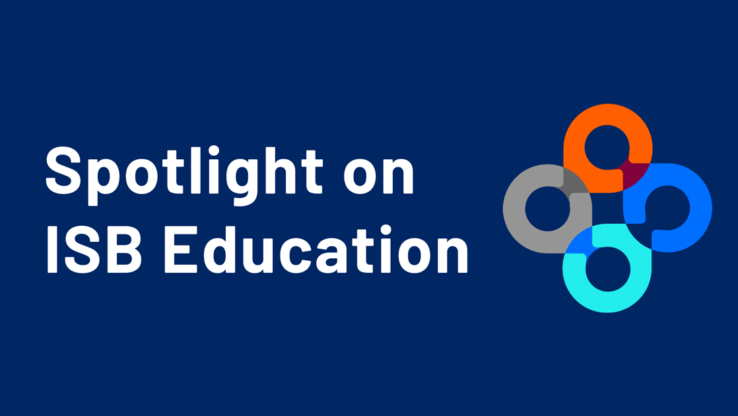Gustavo Glusman Promoted to Principal Scientist
 isbscience.org/news/2015/06/19/gustavo-glusman-promoted-to-principal-scientist/
isbscience.org/news/2015/06/19/gustavo-glusman-promoted-to-principal-scientist/By Dr. Lee Hood
June 19, 2015 – It is an enormous delight for me to announce that Gustavo Glusman has been promoted to Principal Scientist. This is a new position that requires significant scientific accomplishments, a proven ability to raise money for one’s science and a commitment to the cross-disciplinary, open and participatory philosophy of the Institute. Gustavo fulfills these requirements in spades. He joins Monica Orellana and Kai Wang, who previously were promoted to Principal Scientist.
Gustavo was born in Argentina after K-12 school moved to Israel. Gustavo then spent three years in the Israeli army using his computational skills. He trained at two of Israel’s very best education institutions—receiving a BSc at the Technion Institute studying G-proteins in Leishmania and a PhD at the Weismann Institute studying the fascinating Olfactory Receptor supergene family.
Gustavo came to ISB in 2001 and then moved through the ranks—postdoctoral fellow, research scientist and in 2006 was promoted to Senior Research Scientist. Gustavo has published 60 peer review papers—with 13 coming in the last year or so. But what I love about Gustavo is that he has contributed to the life of the Institute in so many different ways—scientifically, socially, leadership, philosophically and as a wonderful cynical skeptic (in the best sense of the word).
Gustavo has played a major role in developing the field of family genomics at ISB. He was a principal contributor to the seminal paper that defined this approach in 2010 in Science. He has pioneered the Gestalt framework for genomic analyses—and as well played a major role in developing the software platform that permits one to use family genome sequencing to rapidly and accurately identify disease genes and even potentially their modifiers. He has pushed the development of critical thinking to pioneer the application of these approaches both to disease, wellness and aging. Indeed, Gustavo characterizes himself as a “genome hacker.” He has thought deeply about how to characterize the quality of short read DNA sequences—and about how to quantify transcriptomes. He has truly been a pioneer in the field of genomics. In sum, Gustavo has collaborated with many of us at ISB—and to all he has brought deep insights and penetrating criticisms. I should also note that Gustavo can at most seminars always be counted on to ask a fundamental question (even if some seminar speakers don’t quite get his point).
Gustavo has parlayed his genomic expertise into a wonderful strategic partnership with the Fairfax, Virginia Community Hospital—Inova. Together with Ilya, they have studied the complete genome sequences (and many other omic data types) of 750 trios—mother, father, infant—for preterm birth biomarkers and fundamental mechanisms. Gustavo has participated in analyzing more than 6000 human genomes in detail—and has contributed enormously in thinking about how to decipher human genomes. Gustavo’s genomic efforts have played a major role in obtaining Inova funding that has been for years at the level of several million dollars per year—and the future for this collaboration looks very promising. Gustavo has also played a significant role in applying for and obtaining several additional grants.
Gustavo has also made major contributions to the genomics (and many other scientific aspects) of the 100 Pioneers wellness project. The genomic analyses serve as a foundational framework for integrating the other omics data that we are gathering—and Gustavo has once again has made original and fundamental observations. Gustavo has also played an important role in the creation of the scientific wellness company—Arivale. We believe that these dense and dynamic data clouds for each individual in the 107 “Pioneers” will serve as the template for what Precision Medicine should be. I might also add that Gustavo (and others) are in the midst of analyzing the 43 Hood genomes that were collected a couple of years ago—and once again fascinating observations will emerge from these data. We feel one of the key genes to identify is that for “determined optimism”—an essential trait for all scientists.
After the science, I think Gustavo’s most important contributions have been his selfless contributions to the benefit of all of ISB (and particularly me). Gustavo in the beginning played a major role in the EAC—an important vehicle for bringing the needs of the younger scientists and staff into appropriate perspective. Gustavo has been a major contributor to Movie night. He set up a Writing Dojo—and helped many of us to learn how to both write grants and papers. He has played an important role in Lee Rowen’s Thursday discussion groups and in helping to manage my lab. And I would be totally remiss if I did not mention his wonderful photography of both formal and informal events.
Gustavo has also become a leader in Seattle of the Quantified Self movement. And has sponsored several of their meetings at ISB. Gustavo has gathered absolutely fascinating data on himself over the past few years. This is all in keeping with the wellness motif that is a fundamental thrust for ISB and for P4 medicine and, indeed should be an objective for all of us.
I would be remiss not to say how much I value Gustavo’s integrity, deep insights and skeptical view of wild new ideas. He has been a wonderful colleague over the years and I cannot emphasize how delighted I am for his promotion. I view Gustavo as a prototype of what a Principal Scientist should be. The future of ISB is in great hands with Gustavo—and all of his talented colleagues for they are the central foundation of ISB’s unlimited scientific potential.




